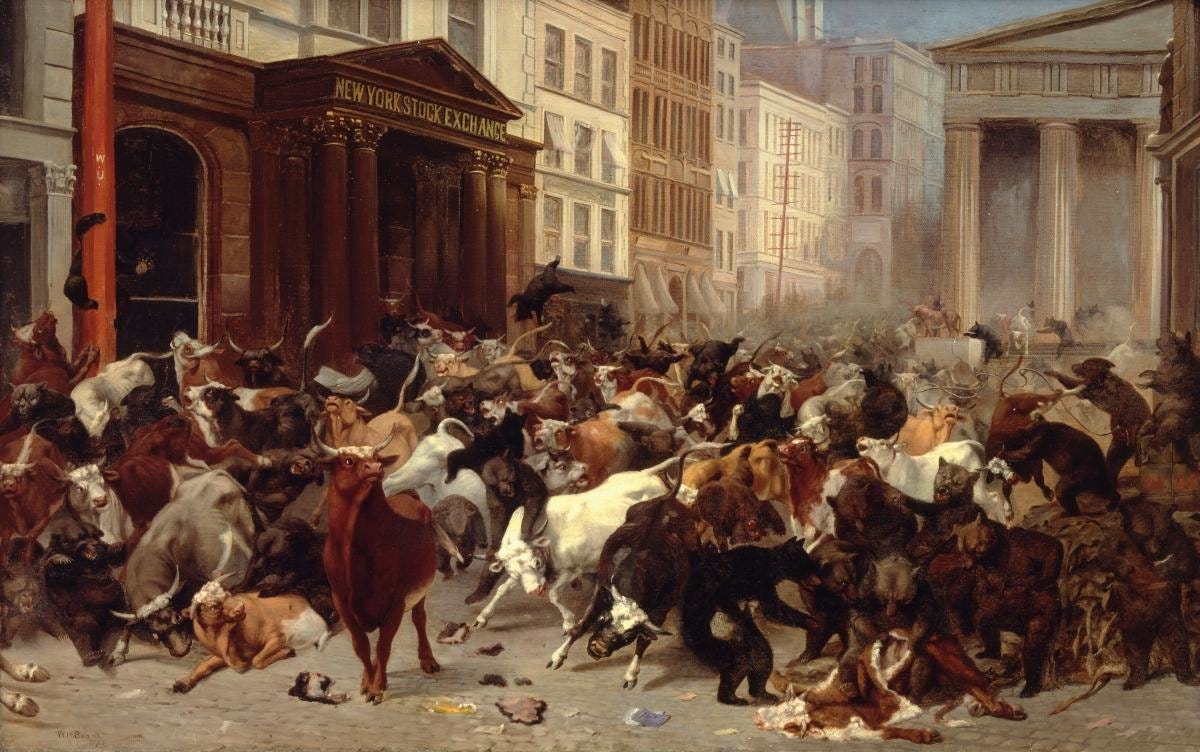The Economics of Aura: Why Reputation Adds to The Price Tag
This week we pull apart the machinery of reputation and momentum and how these forces that turn an artist’s name into cultural currency and send their prices soaring.
Afternoon amigos. Welcome to Week 3 of the Art Valuation Model. One more week to and we can return to talking about the value of art without talking about the Value of Art.
The NY Times published an interesting article last fall, where a handful of young artists saw their value skyrocket at auction during the post-Covid boom of 2021 and plummet dramatically soon after. The crux of the article is that these artists saw great market success momentarily, but because they subverted the traditional institutional systems that help parlay collector buzz into longer asset value, their spark fizzled quickly. Long story short, it's the art market’s fault these young artists did not succeed long term.
This week, we’re turning to the Sentiment Pillar of my Art Valuation Model. Like in financial markets, sentiment in art is finicky, but it is also the biggest ‘alpha’ opportunity.
What is Sentiment and Why Does it Matter?
Alvaro Almeria of The Frame & Flame newsletter (which I highly recommend) often writes how the art world is “less about paintings and more about power.” But what does that mean in practice?
As with financial markets, much of the price in art comes down to sentiment. Before you start quoting the Efficient Market Hypothesis at me, pause for a moment and ask yourself: if markets were truly rational, would we ever have had Gamestop? Would Keynes have bothered with “animal spirits”? No! That is why sentiment is so important.

They are the emotional and psychological currents that drive markets. It’s why stocks can soar far beyond their intrinsic value on little more than hype and collapse even when nothing material has changed.
Understanding sentiment matters because price is never just about value. It is about perceived value. Traders who ignore this often risk missing the real drivers of price action. Those who pay attention can sometimes profit from the gap between hard fundamentals and soft feelings.
The same applies in art. Markets aren’t made on merit alone. They’re shaped by a tangle of subfactors that I break into two parts:
Artist Sentiment: Reputation and Career Momentum
Market Sentiment: Cultural Relevance, Market Trends, and Crowdedness
This week let’s tackle Artist Sentiment...
Artist Reputation
What is it?
If the Objective Factors set the floor for a work’s value, Artist Reputation determines how high the ceiling might go. This factor is a measure of how widely and deeply their work is recognized, respected, and validated by influential players like curators, critics, galleries, collectors, and institutions.
Think of it like brand equity. When you buy a Basquiat, you’re buying into the mythology of Basquiat. That mythology has been carefully cultivated by decades of museum shows, critical reappraisal, and, let’s be honest, a handful of collectors with the liquidity of small sovereign nations and a vested interest in Basquiat’s brand.
How does an artist’s reputation get established?
Reputation rarely comes from talent alone. It emerges through careful curation, shaping the work, crafting the narrative, and surrounding oneself with the right people at the right time. This is why established artists with consistent gallery representation, institutional validation, and critical acclaim command staggering prices. Their reputations are the product of the careful machinery and social engineering of the art market.
Even for younger, less established artists, reputation is paramount. Is there a clear, distinctive voice? A visual language people recognize? Or is the work shapeshifting to meet whatever happens to be fashionable this month?
How to evaluate Artist Reputation:
Gallery representation: Is the artist represented by a dealer who can position the artist in the right circles? Depending on your area of interest, learn who the important dealers are.
Institutional validation: Has this artist been featured in museum shows, biennials, and acquisitions into permanent collections?
Critical acclaim: Has this artist had recognition in the form of reviews, catalog essays, and scholarly attention?
Collector interest: Particularly a good sign when high-profile collectors invest early and signal confidence to the rest of the market.
Why does Artist Reputation matter for a collector?
As a collector, understanding reputation is non-negotiable. You don’t have to buy something because the artist has a good reputation. You have to like the piece and connect with it first. But you also need to understand what you’re paying for.
Reputation is the scaffolding on which markets are built. Ignore it, and you risk overpaying for work that lacks staying power. Study the ecosystems that manufacture reputations: the galleries, residencies, MFA programs, and collectors who act as kingmakers. Ask yourself whether an artist’s acclaim is organic or the product of an inflated hype-cycle.
Also, reputation can be fickle. Knowing the difference between substance and spectacle could mean the difference between holding an enduring work of cultural significance and being left with a very expensive conversation piece.
(It’s worth recalling here our discussion in last week’s newsletter about how provenance and exhibition history act as reputation-building machinery.)
Career Momentum
Momentum is the pace and trajectory of an artist’s rise within the art world. It’s the forward motion that happens when critical recognition, market demand, and institutional support converge to accelerate their visibility and value. Where reputation is about weight and stability; momentum is about speed and direction. It’s dynamic, time-sensitive and prone to volatility.
How does momentum look in the art market and why should you care?
Momentum builds when multiple forces align. As with the stock market, you want to get in on the momentum trade while the price is still low, but you see promising upside. You’re looking for the critical inflection point in an artist’s career where you start to hear their name more often, market demand accelerates, and their cultural relevance solidifies. Momentum creates a self-reinforcing cycle: critical acclaim or gallery representation leads to museum shows, which enhance reputation, attract more collectors, and drive higher prices. Success begets success. The flywheel spins faster.
Long-term momentum can be parlayed into reputational staying power, but be careful not to mistake one for another. Just because an artist is hot now, doesn’t mean a work of theirs will hold its value long term.
In order to understand this mechanism, you also have to think about who is propping up the artist’s career. The art world loves to pretend it’s meritocratic, but it isn’t. Success here is equal parts talent, brand, and the right people whispering your name at the right dinners.

So when considering a piece, ask yourself:
Which galleries have represented this artist? Have they done solo exhibits or just group shows? Are these galleries well connected and putting their weight behind this artist?
Which collectors own their work? What is the reputation of those collectors?
Do any museums own the artist’s work? Are there other institutional heavyweights with a vested interest in this artist’s success?
Does this align culturally with the moment we find ourselves in? (more on this next week)
This scaffolding matters more than most people want to admit. Without it you end up in situations like we described at the outset.
Why Does Career Momentum for a Collector?
Momentum is where the most thrilling opportunities and biggest risks live. Buying into an artist at the right moment can feel like catching lightning in a bottle: “I bought a Warhol from Andy right after I met him at Studio 54.” But momentum can stall. And when it does, resale demand can vanish overnight. Which is why you don’t want to buy on momentum alone, other factors ensure the longevity of your asset’s value.
A note on risk-tolerance
For risk-averse collectors, momentum backed by mega-galleries like Gagosian or Hauser & Wirth offers a sense of security. But do not expect extraordinary upside. You will also need to stomach the less savoury parts of the high-end market: the politicking with gallerists, the “nothing is available at the moment” deflections, and the six-figure entry prices that act as an informal barrier to entry.
At its most extreme, this mentality produces what I call Hedge Fund Art: collections of the same five artists everyone has agreed are valuable, assembled by people who have clearly over-indexed on other people’s opinions and paid an advisor to make sure they’re not embarrassed when their wife’s friends come over for dinner. Snooze.

The real fun lies elsewhere. It is with younger, less tested artists. The real value multiplier comes from spotting who is about to ascend to the next level. Work backwards: study the mega-gallery rosters you respect, then trace their artists’ CVs. Which feeder galleries, residencies, or MFA programs appear again and again? Write them down. Visit those spaces. You will get a warmer reception and a far more interesting experience.
This is how I do my research. Sometimes it is as simple as pounding the pavement on Gallery Row.
Next Week: Market Sentiment
Next week, we’ll move to Market Sentiment—Cultural Relevance, Market Trends, and Collector Depth—and why understanding these forces is essential if you want to collect meaningfully (or avoid becoming the proud owner of the next Beeple).
In the meantime: collect what you love. But know why you’re collecting. And for the love of God, don’t collect art just to make money. It never works.







